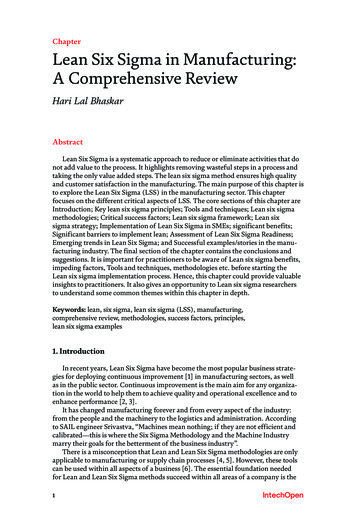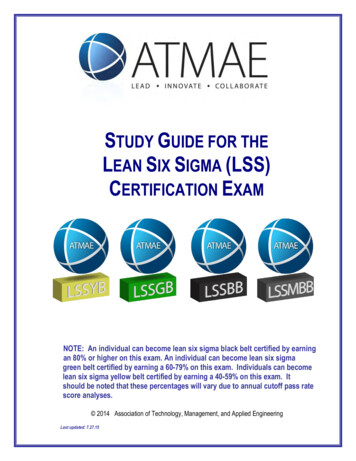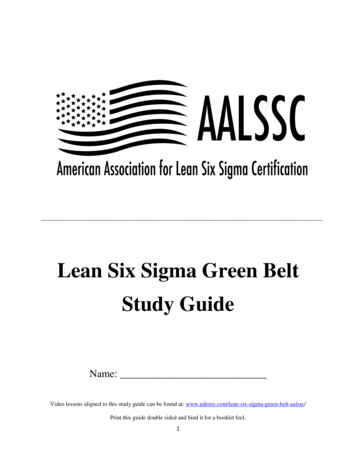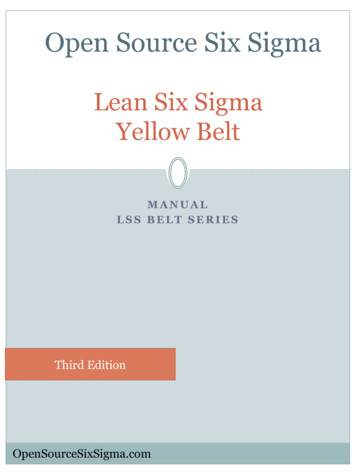
Transcription
ChapterLean Six Sigma in Manufacturing:A Comprehensive ReviewHari Lal BhaskarAbstractLean Six Sigma is a systematic approach to reduce or eliminate activities that donot add value to the process. It highlights removing wasteful steps in a process andtaking the only value added steps. The lean six sigma method ensures high qualityand customer satisfaction in the manufacturing. The main purpose of this chapter isto explore the Lean Six Sigma (LSS) in the manufacturing sector. This chapterfocuses on the different critical aspects of LSS. The core sections of this chapter areIntroduction; Key lean six sigma principles; Tools and techniques; Lean six sigmamethodologies; Critical success factors; Lean six sigma framework; Lean sixsigma strategy; Implementation of Lean Six Sigma in SMEs; significant benefits;Significant barriers to implement lean; Assessment of Lean Six Sigma Readiness;Emerging trends in Lean Six Sigma; and Successful examples/stories in the manufacturing industry. The final section of the chapter contains the conclusions andsuggestions. It is important for practitioners to be aware of Lean six sigma benefits,impeding factors, Tools and techniques, methodologies etc. before starting theLean six sigma implementation process. Hence, this chapter could provide valuableinsights to practitioners. It also gives an opportunity to Lean six sigma researchersto understand some common themes within this chapter in depth.Keywords: lean, six sigma, lean six sigma (LSS), manufacturing,comprehensive review, methodologies, success factors, principles,lean six sigma examples1. IntroductionIn recent years, Lean Six Sigma have become the most popular business strategies for deploying continuous improvement [1] in manufacturing sectors, as wellas in the public sector. Continuous improvement is the main aim for any organization in the world to help them to achieve quality and operational excellence and toenhance performance [2, 3].It has changed manufacturing forever and from every aspect of the industry:from the people and the machinery to the logistics and administration. Accordingto SAIL engineer Srivastva, “Machines mean nothing; if they are not efficient andcalibrated—this is where the Six Sigma Methodology and the Machine Industrymarry their goals for the betterment of the business industry”.There is a misconception that Lean and Lean Six Sigma methodologies are onlyapplicable to manufacturing or supply chain processes [4, 5]. However, these toolscan be used within all aspects of a business [6]. The essential foundation neededfor Lean and Lean Six Sigma methods succeed within all areas of a company is the1
Lean Manufacturing and Six Sigma - Behind the Maskcapability to recognize waste, decrease the waste, and forcefully attempt to eliminate all activities that do not add value or increase customer satisfaction both withinthe company and outside.These methods are not a new phenomenon. In fact, the Lean methodologyhas been an effective tool since the dawn of the industrial age [7, 8]. The idea ofimproving performance and meeting the expectations of customers while stillimproving the bottom line has always been the goal of businesses [9]. The evolutionof Lean and Lean Six Sigma is based on understanding what methods or mixture ofmethods should be used to ensure the biggest impact to the business. The Six SigmaDMAIC (Define, Measure, Analyze, Improve, and Control) foundation is the basefor our Lean training and service programs [10, 11].Six Sigma basics are designed to improve manufacturing [12, 13]. This is a typeof quality control that was originally developed for large scale manufacturers. It wasintended to enhance processes and eliminate the amount of defects found withinthem. The Lean method is a philosophy centered around eliminating waste andproviding the best customer experience [14]. According to the Lean manufacturingsubject matter expert, there are eight kinds of waste: defects, overproduction, waiting, non-utilized talent, transportation, inventory, motion, and extra processing.Researchers believe that it is very important to conduct a comprehensive reviewin manufacturing field to understand the each aspect of Lean Six Sigma. Researchon “Lean Six Sigma in manufacturing” is limited and state that no standard workdone for such a combination exists.Hence, the aim of this chapter is to address such gaps within Lean Six Sigma(LSS) and manufacturing that allow them to achieve the most benefits from thisstrategy, as well as to identify the gaps and give recommendations for futureresearch. To achieve the overall aims of this chapter, the author has comprehensively reviewed the literatures in second section.2. Comprehensive review2.1 Lean and six sigmaThe concept of lean thinking can be traced to the Toyota production system(TPS), a manufacturing philosophy pioneered by the Japanese engineers TaiichiOhno and Shigeo Shingo [15, 16]. The development of this approach to manufacturing began shortly after the Second World War while employed by the Toyota motorcompany [17]. Lean manufacturing extends the scope of the Toyota productionphilosophy [18] by providing an enterprise-wide term that draws together the fiveelements of “the product development process, the supplier management process,the customer management process, and the policy focusing process for the wholeenterprise” [17]. Lean Six Sigma has been defined as “a business improvementmethodology that aims to maximize shareholders’ value by improving quality,speed, customer satisfaction, and costs: it achieves this by merging tools and principles from both Lean and Six Sigma” [19]. Gershon and Rajashekharaiah [20] pointout that “leading texts fail to define Lean Six Sigma as a unique methodology”.Laureani and Antony [21] stated that “Lean Six Sigma uses tools from bothtoolboxes in order to get the best from the two methodologies, increasing speed whilealso increasing accuracy”. Both Lean and Six Sigma require a company to focus on itsproducts and customers [19]. According to Stoiljković et al. [22], the concepts of leanand six sigma are intertwined in that Lean speed enables Six Sigma quality and SixSigma quality enables Lean speed. Pepper and Spedding [17] and Ferng and Price [23]similarly identify that Lean thinking may be used to identify areas of improvement2
Lean Six Sigma in Manufacturing: A Comprehensive ReviewDOI: http://dx.doi.org/10.5772/intechopen.89859Figure 1.Lean, six sigma and lean six sigma. Source: [27].and set standards, while the Six Sigma methodology may be used for targeting themand for investigating deviations from said standards. The foundation of the leanvision is still a focus on the individual product and its value stream (identifyingvalue-added and non-value added activities), and the main target of lean thinking isto eliminate all waste, or muda, in all areas and functions within the system [16, 17].Lean Six Sigma is a combination of two powerful process improvement methods:Lean and Six Sigma [24–26]. It decreases organization’s costs by: Removing “Waste” from a process: Waste is any activity within a process that isnot required to manufacture a product or provide a service that is up to specification [36, 37]. Solving problems caused by a process: Problems are defects in a product orservice that cost your organization money [36, 37] (Figure 1).2.2 Integrating lean and six sigmaLean and Six Sigma are the two most important continuous improvement (CI)methodologies for achieving operational and service excellence in any organization[29–33]. LSS is the fusion of two most powerful process excellence methodologies,namely, Lean and Six Sigma [24].According to Sokovic and Pavletic [34] Lean means speed and quick action(reducing unnecessary wait time) and Six Sigma means identifying defects andeliminating them. As well as Lean Six Sigma Engineering means best-in-class. It creates value in the manufacturing or service organization to benefit its customers andsaves money without capital investment [34].Six Sigma is a well-established approach that seeks to identify and eliminatedefects, mistakes or failures in business processes or systems by focusing on thoseprocess performance characteristics that are of critical importance to customers’[35]. It is a statistical methodology that aims to reduce variation in any process,reduce costs in manufacturing and services, make savings to the bottom line,increase customer satisfaction, measure defects, improve product quality, andreduce defects to 3.4 parts per million opportunities in an organization [35, 36].The high cost of Six Sigma training is a barrier for many organizations to deploythis methodology [37, 38]. In fact, deploying Six Sigma in isolation cannot removeall types of waste from the process, and deploying Lean management in isolationcannot control the process statistically and remove variation from the process [35].Therefore, some companies have decided to merge both methodologies to overcomethe weaknesses of these two methodologies when they have been implemented inisolation and to come up with more powerful strategy for continuous improvement3
Lean Manufacturing and Six Sigma - Behind the MaskFigure 2.Concept of lean six sigma. Source: [28].Figure 3.Lean and six sigma popularity and integration. Source: [35].and optimizing processes [35, 39, 40]. In fact, LSS are completing each other andthere is an obvious relation between both methodologies, which makes it possiblefor the synergy of the two methodologies (see Figures 2 and 3). Therefore, theintegration of these two approaches gives the organization more efficiency andaffectivity and helps to achieve superior performance faster than the implementation of each approach in isolation [30, 35, 41].4
Lean Six Sigma in Manufacturing: A Comprehensive ReviewDOI: http://dx.doi.org/10.5772/intechopen.89859Salah et al. [30] has indicated that the integration of lean and Six Sigma is thesolution to overcome the shortcomings of both, as they complete each other. Thisintegration helps companies to achieve zero defects and fast delivery at low cost.According to Bhuiyan and Baghel [42] the combination of this two is the way fororganizations to increase their potential improvement.The integrated approach to process improvement (using Lean and Six Sigma)will include: Using value stream mapping to develop a pipeline of projects that lend themselves either to applying Six Sigma or Lean tools [34, 43]. Teaching Lean principles first to increase momentum, introducing the SixSigma process later on to tackle the more advanced problems [34, 43]. Adjusting the content of the training to the needs of the specific organization—while some manufacturing locations could benefit from implementingthe Lean principles with respect to housekeeping, others will have these basicsalready in place and will be ready for advanced tools [34, 43].The following roadmap provides an example for how one could approach theintegration of Lean and Six Sigma into a comprehensive roadmap (Figure 4).Therefore, many manufacturing firms are looking for an approach that allowsto combines both methodologies into an integrated system or improvementroadmap [44, 45]. However, the differences between the Six Sigma and Lean areprofound (Table 1).Figure 4.Integrating lean and six sigma roadmap. Source: [44].5
Lean Manufacturing and Six Sigma - Behind the MaskLeanSix sigmaGoalCreate flow and eliminate wasteImprove process capability and eliminatevariationApplicationPrimarily manufacturing processesAll business processesApproachTeaching principles and “cookbook style”implementation based on best practiceTeaching a generic problem-solvingapproach relying on statisticsProject selectionDriven by value stream mapVarious approachesLength of projects1 week to 3 months2–6 monthsInfrastructureMostly ad-hoc, no or little formal trainingDedicated resources, broad-based trainingTrainingLearning by doingLearning by doingSource: Prepared by the author.Table 1.Comparing lean and six sigma.Figure 5.Integrating lean tools and six sigma DMAIC cycle. Source: [46].Duarte [46] identify that Lean Six Sigma has become a widely recognizedprocess improvement methodology and has been adopted by many companies likeFord, DuPont, 3 M, Dow Chemicals, and Honeywell etc. At present, the methodology of Lean Six Sigma has been carried out in 35% of companies listed in the Forbestop 500 [46]. He illustrates how Lean tools can be incorporated into the Six SigmaDMAIC (Define, Measure, Analyze, Improve, and Control) cycle (Figure 5).6
Lean Six Sigma in Manufacturing: A Comprehensive ReviewDOI: http://dx.doi.org/10.5772/intechopen.898592.3 Basics of lean six sigmaIn the efforts to draw nearer to customers, several manufacturers have lostfocus on what ought to be a company’s primary success factor—profitablegrowth. In today’s competitive manufacturing environment, it takes more thanquick fixes, outsourcing and downsizing for firms to systematically achieve theirgrowth and profit objectives [47]. Whereas these choices could yield temporaryfinancial relief, they will not lead the way to long-term growth and profitability.Therefore, they have to bring lean to grow and continually exceed bottom lineexpectations; and to bring lean they must master eight basics of Lean Six Sigmafor manufacturing.2.3.1 Software as the solutionIn digital and cloud based environment, the physical database is replaced bya virtual database. Data are transferred throughout the cloud computing [48].Organizations were led to believe that computerized systems would provide thesolution to all growth and profit challenges. Material requirements planning (MRP)and enterprise resource planning (ERP) system gurus assured companies that ifthey implement their software programs at bottom line, would take care of itself.In a typical company, converting the quarterly financial forecast into reality stillrequires overtime, internal/external expediting, last minute “on-the-run” productchanges and even some “smoke and mirrors” from time to time [49]. Results arescrap, rework and warranty costs that negatively impact profitability and quality,and shipment problems that deliver less than acceptable customer satisfaction [47].Companies have spent thousands of dollars in pursuing MRP and ERP only to seegrowth and profits decline due to uncontrolled operating costs that produced noncompetitive pricing [39, 40]. Thus, softwares can be a solution for these problems,and eliminate the root causes of ineffective systems and processes.2.3.2 How to get to root causesManufacturers can get the root causes by in-depth understanding of thefundamentals of Six Sigma and then a total reliable commitment and determinedexecution of eight basics of Lean Six Sigma. Like renowned football coach VinceLombardi, who achieved success by having his team focus on the mastery offootball basics, manufacturing teams need to focus on the mastery of the Leanmanufacturing basics. These basics require proactive planning and inflexibleimplementation that demands leadership above and beyond just satisfying dayto-day accountabilities. Some managers cannot imagine the benefits of mastering manufacturing basics. Others simply cannot find the time. Like practicingblocking and tackling in football, it is not exciting. And like most football heroes,managers prefer to run with the ball. But without the solid execution of Lean SixSigma basics, companies will seldom achieve their full growth and profit potentials[44, 47]. Here are the eight basics of Lean Six Sigma which every manager shouldknow and implement: Information integrity: It is common for front office management to becomedisappointed with computerized systems results when time schedules andpromised paybacks are not achieved. It is a given that acceptable systemsresults cannot be achieved when systems are driven by incorrect data and inappropriate, uncontrolled documentation [44, 47, 50].7
Lean Manufacturing and Six Sigma - Behind the Mask Performance management: Measurement systems can be motivational orde-motivational. The individual goal-setting of the 1980s is a good example ofde-motivational measurement—it tested one individual or group against theother and while satisfying some individual egos, it provided little contributionto overall company growth and profit. Today, the balanced scorecard is thechoice of business winners [44, 47, 50]. Sequential production: It takes more than systems sophistication for manufacturing companies to gain control of factory operations. To achieve on-timeshipments at healthy profit margins, companies need to replace obsolete shopscheduling methodology with the simplicity of sequential production [51].Manufacturing leaders have replaced their shop order “launch and expedite”methodology with continuous production lines that are supported by realtime, visual material supply chains sequential production. The assertion thatsequential production only works in high production, widget-manufacturingenvironments is a myth [44, 47, 50]. Point-of-use logistics: Material handling and storage are two of manufacturing’s high cost, non-value-added activities. The elimination of the stockroom, as it is known today, should be a strategic objective of all manufacturers. Moving production parts and components from the stockroom to theirproduction point of use is truly a return to basics and a significant costreducer [44, 47]. Cycle time management: Long cycle times are symptoms of poor manufacturing performance and high non-value-added costs [44, 52]. Manufacturersneed to focus on the continuous reduction of all cycle times. Achieving successrequires a specific management style that focuses on root cause, proactiveproblem solving, rather than “fire-fighting” [44, 47]. Production linearity: Companies will never achieve their full profit potentialif they produce more than 25% of their monthly shipment plan in the last weekof the month or more than 33% of their quarterly shipment plan in the lastmonth of the quarter. How linear does a production department produce to thecompany’s master schedule? As companies struggle to remain competitive, oneof the strategies by which gains in speed, quality and costs can be achieved is toform teams of employees to pursue and achieve linear production [44, 47]. Resource planning: One of the major challenges in industry today is the timelyright sizing of operations. Profit margins can be eroded by not taking timelydownsizing actions, and market windows can be missed and customers lost bynot upsizing the direct labor force in a timely manner. These actions demandtimely, tough decisions that require accurate, well-timed and reliable resourceinformation [44, 47]. Customer satisfaction: Customer satisfaction is the main driver of loyalty.It affects company’s financial performance and perception of the customers [53]. Perceptions are what a company needs to address when it comes toimproving customer satisfaction. It does not good to have the best productsand services if the customer’s perception of “as received” quality and serviceis unsatisfactory. Companies need to plan and implement proactive projectsthat breakdown the communication barriers that create invalid customerperceptions [44, 47, 54, 55].8
Lean Six Sigma in Manufacturing: A Comprehensive ReviewDOI: http://dx.doi.org/10.5772/intechopen.898592.4 Key lean six sigma principlesLean six sigma principles mainly refer to process improvements, although theirpractical implementation has different impacts according to different organizational models [56]. Leaders at all levels are working to integrate lean and Six Sigmaprinciples into all business processes, including product design and development,integrated supply chain, marketing and sales, customer service, infrastructure,governance and strategy deployment [57].According to Lucid chart Content Team, for a process stream that produces thebest results; consider the following Lean Six Sigma principles for your organization.1. Focus on the customer: Before you start making any drastic or even minorchanges, establish the level of quality or requirements that you have promisedyour customers.2. Figure out your value stream: You need to see the current state of your process before you can move forward and make improvements. Identifying valuestream is unquestionably what makes Lean Six Sigma principles so effective.A value stream map showcases every single step, including purchasing parts,assembling them (and checking for quality assurance), and distributing thefinished product. You must determine which steps add value and which do not.3. Take out the trash: Remove any non-value-added activities or opportunitiesfor defects. On value stream map, avoid highlighting areas that are workingfluidly. If your value stream map does not clarify exactly where the problemlies, you can use several other diagrams to work through potential root causesof the issue. For example: Cause-and-effect diagrams.4. Keep the ball rolling: Workers will keep performing (or not performing) thesame tasks until management decides otherwise. The responsibility of businessis to communicate the new standards and practices effectively and clearly. Besure each employee receives training and feedback. Otherwise, why expect theproblem to change? Thus, nothing will change until change is enacted.5. Create a culture of change and flexibility: Lean Six Sigma requires a lot ofchange [58]. You need to welcome change and encourage your employees to accept change as well. As part of this cultural shift, your company should alwayslook for new ways to streamline the process and remove waste. Keep your eye onthe data, examine your bottom line, and adjust your processes where necessary.Womack and Jones [59] has summarized five Lean Six Sigma Principles in “Leanthinking—banish waste and create wealth in your corporation” as follows:1. Specifying value: “Value is only meaningful when expressed in terms of aspecific product or service which meets the customer needs at a specific priceat a specific time.”2. Identify and create value streams: “A Value stream is all the actions currentlyrequired to bring a product from raw materials into the arms of the customer.”3. Making value flow: “Products should flow through a lean organization at therate that the customer needs them, without being caught up in inventory ordelayed.”9
Lean Manufacturing and Six Sigma - Behind the Mask4. Pull production not push: “Only make as required. Pull the value according tothe customer’s demand.”5. Striving for perfection: “Perfection does not just mean quality. It means producing exactly what the customer wants, exactly when the customer requiresit, at a fair price and with minimum waste.”Womack et al. [60] defined the five principles of Lean manufacturing in theirbook “The Machine That Changed the World”. The five principles are considereda recipe for improving workplace efficiency and include: (1) defining value, (2)mapping the value stream, (3) creating flow, (4) using a pull system, and (5) pursuing perfection. The principles encourage creating better flow in work processesand developing a continuous improvement culture. By practicing all these fiveprinciples, an organization can remain competitive, increase the value delivered tothe customers, decrease the cost of doing business, and increase their profitability.These Lean principles can be applied to any process to reduce the wastes (Figure 6).2.5 Lean six sigma frameworks and methodologiesLean six sigma is a systematic data driven methodological philosophy centeredaround eliminating waste, reducing process variation [61] and providing the bestcustomer experience [45]. According to the Lean method, there are eight kindsof waste: defects, overproduction, waiting, non-utilized talent, transportation,inventory, motion, and extra processing [62]. Lean six sigma is a structured problem solving methodology [63]. The lean six sigma framework aim at providing aneffective approach to integrating lean and six sigma [65]. It uses the DMAIC phasessimilar to that of Six Sigma [32]. Problem solving in lean Six Sigma is done usingthe DMAIC framework. It has been implemented and verified at one engineeringcompany in UAE [32]. The results show that the process “Make-to-Order (MTO)projects” has a long lead-time [32]. The main causes of the long lead-time are thesubcontractors, the customers, and the company-implemented procedures [32].Figure 6.The five lean principles [64].10
Lean Six Sigma in Manufacturing: A Comprehensive ReviewDOI: http://dx.doi.org/10.5772/intechopen.89859Using the framework, it was possible to identify the most significant reason forthe long lead-time, analyze the root-cause(s), suggest three relevant solutionsand select the most preferred one [32]. In this methodology framework application, lean-production, six-sigma, balanced scorecard, simulation and cost benefitanalysis tools were used.A study was conducted in India by Ben Ruben et al. [61] using DMAIC framework methodology and validated practically to provide both operational andenvironmental benefits. The framework is validated with an industrial case studyconducted in an Indian automotive component manufacturing firm/organizationlocated at Tamilnadu. The firm manufactures high precision transmission. On thesuccessful deployment of the framework, the internal defects was brought down to6000 ppm from 16,000 ppm and environmental impacts was reduced to 33 Pt from42 Pt. Deployment of the developed framework helped in improving the firm’s sigmalevel and also reduced the overall environmental impacts. In this research differentlean six sigma tools were used at different level/phase like-Value Stream Mapping(VSM), 5S, Kaizen, Cause and effect diagram, Quality Function Deployment (QFD),High level SIPOC, Eco-QFD, Pareto chart, Environmental VSM (current level),life Cycle Impact Assessment, Brainstorming, Design of Experiments, Cost benefitanalysis, Design for Environment, Life Cycle Interpretation, Environmental VSM(Future level), 7s practices, Standard operating Procedure (with environmentalmetrics) and Performance evaluation tools.Thus, using the framework methodology the user will have a systematicapproach for continues improvement. Because, this framework also allows theuser identify the process problem(s) and solve them effectively [32]. There arefive stages in this framework. They are Define, Measure, Analyze, Improve, andControl [66] (Figure 7).Hill et al. [45] has developed an initial conceptual Lean Six Sigma Framework(LSSF) and undertook a series of iterative developments in an attempt to improveits effectiveness and suitability to Maintenance Repair and Overhaul (MRO)implementation. Hill et al. [45] describes the novel implementation of an integratedLSS framework and outlines how it was used to identify the factors that affect supply chain performance in an aerospace Maintenance Repair and Overhaul (MRO)facility. It shows how each of the Six Sigma DMAIC phases are applied systematically to each of the Lean stages. Stage (0) of the LSSF was the starting point of theimplementation stage. The phases are as follows:LSS Phase 1—Specify value by defining the CTQ issue.LSS Phase 2—Align the internal operations through measuring the extent of theProblem.LSS Phase 3—Create flow by identifying constraints in the system.LSS Phase 4—Create flow through process improvement.LSS Phase 5—Continuous improvement and control of future processes (Figure 8).Hill et al. [45] outlined the application and measures the effectiveness of theintegrated LSS framework through its ability to achieve new and enhanced performance through simultaneously reducing late material calls and reducing andstabilizing Order To Receipt (OTR) times.2.6 Tools and techniquesLean and Six Sigma both have their own set of tools and techniques that canenhance a company’s objectives for value and profit enhancement [24]. Lean sixsigma consists of many tools and techniques for continuous improvement such asthe Kanban system, 5S, Cause and Effect analysis (C&E), Value Stream Mapping(VSM) and many others [35, 36]. According to Brazilian publications, there are11
Lean Manufacturing and Six Sigma - Behind the MaskFigure 7.Lean six sigma framework and methodology. Source: [66].Figure 8.Integrated generic lean six sigma framework (LSSF). Source: [45].six most frequently tools used in LSS applications: “Control Charts”, followedby “Value Stream Mapping”, “DMAIC,” “Kaizen,” “Ishikawa Diagram,” and“Histogram;” and Control chart is the top ranking tool [33]. DMAIC is a five step12
Lean Six Sigma in Manufacturing: A Comprehensive ReviewDOI: http://dx.doi.org/10.5772/intechopen.89859Lean Six Sigma (LSS) toolsAuthor(s)Control Charts[10, 24, 33, 67]Value Stream Mapping (VSM), Box plot, Process mapping,Standardized work, Scatter diagram, Cause and effect matrix (C&Eanalysis), Kanban system, Hypothesis Testing, Process Flow Diagram,Quick, 7 waste analysis, Heijunka[10, 24, 31, 35, 67]DMAIC or DMADV[10, 24, 67, 68]Kaizen, Single Minute Exchange of Die (SMED)[24, 67, 68]Ishikawa Diagram, Histogram, Stratification[10, 24]Pareto Chart, E-Kanban system, SOP, Check sheet, VOC translationmatrix, Three diagrams, Brainstorming, SIPOC Diagram[10, 24, 31]Current state map, Spaghetti diagram, Poka-yoke[24, 67]5S, 5 Whys, XY matrix, FMEA, ANOVA, Design of Experiments(DOE), Rootcause Analysis, Mistake proofing, VSM, Pareto chart,CTQ analysis, Root-cause analysis, Jidoka[10, 24, 31, 35, 67]Process Capacity Analysis, Cause and effect diagram[10, 24, 31]Changeover, Total Productive Maintenance (TPM), Line balancing;Cellular manufacturing,[24, 67]Critical to Customer Tree—VOC/VOB[24]OEE, DMADV, Autonomation (Jidoka), Visual management[24]5W1H, JIT, Regression analysis, QFD, Statistical Process Control(SPC), Kano Model, Gemba (Go & See)[24, 31, 35, 39, 67, 68]Confidence Interval, Continuous Flow, Benchmarking[24]
Lean Manufacturing and Six Sigma - Behind the Mask 6 Figure 5. Integrating lean tools and six sigma DMAIC cycle. Source: [46]. Duarte [46] identify that Lean Six Sigma has become a widely recognized process improvemen











